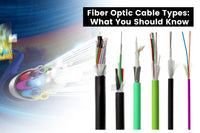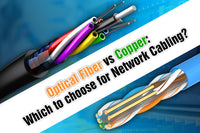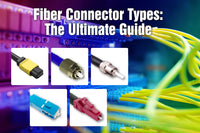Fiber optic cables are a popular alternative to copper cables. They are often used with fiber connectors in network transmission.
Are you familiar with fiber optic connectors? Fiber connectors are devices to help connect fiber cables to your network equipment. They come in various types such as LC, SC, MTP, and FC connectors, among which LC and SC connectors are the most commonly used ones. Do I choose LC or SC connectors? This has been constantly a hot topic. We'll introduce LC and SC connectors and explain their differences in this article.
Overview of Fiber Optic Connectors
Different from copper cables, fiber optic cables are the medium that transmits light instead of electrical signals. Therefore, fiber optic connectors should be carefully manufactured to ensure precision. Fiber connectors are usually composed of ferrules and connector bodies. Different fiber optic connectors feature different coupling mechanisms.
These connectors come in a variety of types to meet different needs. For example, there are fiber connectors used for simplex or duplex connections. Among so many fiber optic connectors including FC, LC, SC, ST, CS, MTP, MDC, and MT connectors, LC and SC connectors are commonly used in fiber network transmission.
What Are SC Connectors?
Created by the NTT laboratories in the mid-80s, SC or Standard Connectors, also known as Subscriber connectors and Stick-and-Click connectors, are one of the oldest fiber connectors. The name arises from its nature (square connector) despite the reality that it is a rectangular connector.

Although different SC connectors feature different structures, a basic SC connector mainly consists of a dust cap, connector housing, inner frame, spring, stopper, and boot. The SC connector has a locking tab with a push-pull latching mechanism, which is easy to connect and disconnect. It features a ceramic ferrule to provide accurate alignment and ensure low insertion loss. SC connectors are widely used in passive optical networks thanks to their high-precision signals.
Popular features:
- Coupling Type: Pull-push
- Ferrule diameter: 2.5 mm
- Mating cycles: 1000
- Applications: Datacom and telecom, internet and cable TV, media converters, FTTX (EPON), etc.
What Are LC Connectors?
LC connectors are also called Lucent Connectors, Little Connectors or Local Connectors. The name comes from the Latin word light-bearing, which means that the connector can transfer data on a beam of light. Developed by Lucent Technologies in the early 2000s, LC connectors have become one of the most popular fiber optic connectors on the market.

The basic LC connector is mainly composed of the dust cap, connector housing, ferrule, spring, and boot. The connector uses a latch locking mechanism. It features a ceramic ferrule of 1.25mm, which is almost half a size smaller than the SC connector. LC connectors have two versions, one is used for fiber patch cables, and the other is known as a behind-the-wall (BTW) connector. They are especially useful in high-density situations where regular maintenance is necessary.
Popular Features:
- Coupling type: Latch
- Ferrule diameter: 1.25 mm
- Mating cycles: 500
- Applications: High-density connections, SFP and SFP+ transceivers, XFP transceivers
LC vs SC: What Are The Differences?
SC and LC connectors share many features. For example, they provide almost the same insertion and return loss and both of them are employed in data centers or server rooms. So, what makes SC and LC connectors different from each other? Read on for more information.
History
The LC is the younger counterpart of SC, which is globally dispersed, but LC is catching up. They have taken the same family values with regard to their insertion loss (0.25-0.5 dB) and return loss functions. It mainly depends on where in the network you will need to make use of the connector, independent of SC or LC, even the variant-specific types of connector.
Ferrule Size
A 'ferrule' is a small tube or a mechanical device placed at the end of the connector to safeguard fiber. SC connector has a 2.5mm ferrule while LC has a 1.25mm ferrule, which is half of SC's.
The small size of the LC connector makes it more frequently used when there are 'pools' of fiber optic cables close to one another, including offices and data centers.
Mechanism
The SC connector works with a push-pull mechanism, which means that it would be put or driven when you press down something instead of turning or pushing against the direction.
However, the LC connector works using a latch, replacing the pierce method for its simplicity and miniaturization so that it has higher demand.
Cost
Compared to SC connectors, the cost of LC connectors is higher due to their complicated and innovative design. SC connectors can be more cost-effective as they have a relatively simple construction and mature technology.
Durability
The two fiber optic connectors have equal capacity for the insertion loss (signal or data packets of 0.25 to 0.5db) and return loss values and perform well for very high speeds and long-lasting connection durability.
But they have different mating cycles. The lifespan of SC connectors is 1000 mating cycles, while that of LC connectors is 500 mating cycles.
Applications
SC and LC connectors are critical for the development of high-speed internet infrastructure.
LC connectors are generally used in high-density applications in telecommunications, fiber optic patch panels for data centers and server rooms.
SC connectors are a bit larger and they are used for general purposes like connecting fiber optic with a computer, Wi-Fi router, or any gaming consoles. They are your go-to option for single-mode and multimode systems.
In addition, fiber optic adapters or hybrid cables can be used to convert the SC connectors into LC and vice versa. These adapters facilitate the interconnection of various connector types, hence ensuring the compatibility of fiber optic systems.
|
Comparison |
SC Connector |
LC Connector |
|
Ferrule Size |
2.5mm |
1.25mm |
|
Mechanism |
Pull-push Mechanism |
Latch Locking |
|
Cost |
More Cost-effective |
Expensive
|
|
Durability |
1000 Mating Cycles |
500 Mating Cycles |
|
Insertion Loss |
0.25-0.5db |
0.25-0.5db |
|
IEC Specification |
61754-20 |
61754-4 |
|
Application |
General purposes like connecting a fiber optic cable to a computer, Wi-Fi router, or gaming console |
Especially suitable for High-density network telecommunications such as data centers and server rooms |
LC vs SC: Which One Should You Choose?
Whether to choose LC or SC connectors depends on your specific needs. For example, if space saving matters for your fiber optic network, LC connector is your go-to option for the needs of a high port density.
In applications of long-distance data transmission, single-mode fiber optic cables with LC connectors are preferred for their less signal loss and larger bandwidth.
If you just want to use fiber optic for general purpose, SC connectors are enough for providing high-speed network speed.
Conclusion
In conclusion, with so many fiber optical connectors access to the network, both FC and LC connectors stand out for their great performance. These connectors are favored for their lower insertion loss, which are widely used in high-speed network applications. Understanding the differences between FC and LC connectors helps you find the right type for your optical communication needs. But the final decision comes down to what would meet the needs of each installation.
FAQs
Is LC single mode or multimode?
In fact, they come in both single mode or multimode. Single-mode LC connectors are more capable of higher bandwidth transmission over long distances, while multi-mode LC connectors are more suitable for lower bandwidth and shorter-distance transmission.
What is the difference between green and blue SC connectors?
To identify the connections, you can check their colors. Blue typically signifies UPC (ultra physical contact) single-mode connections, while green features APC (angled physical contact) single-mode connections.
Is fiber internet better than Wi-Fi?
Not really. In terms of performance, fiber internet can transfer data at a higher speed rate, while Wi-Fi internet speed is getting lower when there are multiple users or over long distances. In terms of convenience, for example when you are on a business trip or go out, you can access the nearby wireless web without carrying wires.
For more information on this topic, you can keep up on our blogs. While VCELINK offers general and basic information for our customers and other visitors to the website, it’s not professional advice.



